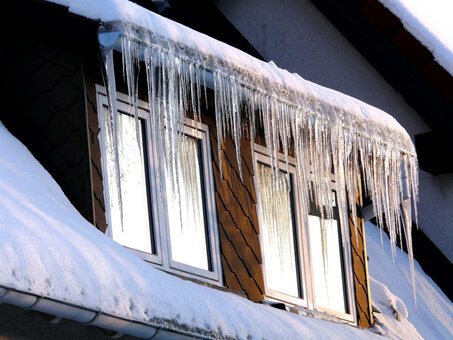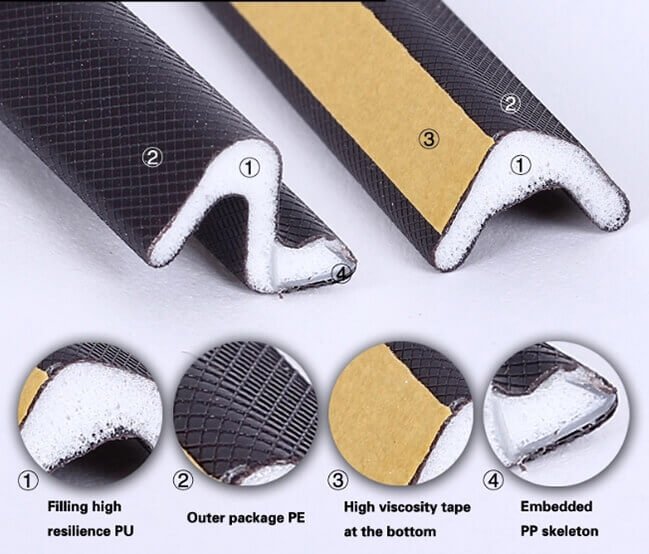
Is the cost of heating your home in winter sending a cold shiver down your spine? Weatherizing your home could be the answer.
There are many weatherization methods to choose from. An easy and often low-cost one is to weatherstrip windows.
This article takes a close look at window weatherstripping. It covers where and how to install window weatherstrip to maximize its benefits. It also introduces you to several types of window weather strips.
How do I stop cold air from coming through my window?
Windows and doors are major sources of heat-loss from homes in the winter. Windows do it more because there are usually many more of them. Any cracks and gaps in them let warm air out and cold air in.
Let’s first look at three other ways you can deal with drafty windows.
Caulking
Caulking is traditionally used to seal gaps between a window and the wall. It is usually the choice for external window trim. Caulking windows on the inside is often done with the help of filler material. Good examples are caulk saver backer rods or rope caulk.
Thermal Window Treatments
Internal window coverings range from shades and blinds to curtains and drapes. Some modern types focus on energy efficiency. Some options for external thermal window treatments are shutters, awnings, and exterior solar screens.
Low-E Glass Storm Windows
Low-Emittance, or Low-E windows, have a special coating on the glass. It reflects heat back into the room in winter. (It reflects heat back outside in the warmer months.) The windows reduce drafts. Plus, they come in both fixed and operable designs.
Check out Energy.gov for more information on types of energy-efficient window coverings.
Weatherstripping is one way to counter this. We cover it in great detail here.
Window weather strip types
Here is a rundown of the seven most common types of window weather stripping. Some sealing jobs may call for the use of more than one. This is typically the case for irregularly shaped gaps.

Adhesive-Backed Foam Tape
This kind of self-stick weatherization tape is weather-resistant. Daoseal’s PU Coating Seal comes with a shockproof PU sponge filling. It regains its shape after compression. The outer PE coat is durable enough for use in high-wear areas.
EPDM Rubber Weatherseal Tape
Daoseal EPDM Rubber seal Tape is self-adhesive and does not harden or crack. It still works at sealing out both air and moisture in temperatures well below freezing. The tape also regains its shape after compression.

FELT
This is an inexpensive and easy-to-apply option. It is suitable for use in areas where it is not subjected to moisture or to high levels of wear and tear. The all-wool type has much greater durability.
Vinyl V Strips
This self-stick V-shaped weatherstripping is both durable and highly effective. It is moderately priced and practically invisible when properly installed.
Pile Weather Strip
This is also called fin seal. It is made up of dense fibres attached to a thin metal strip. It is a very durable, moderate-to-high priced option. It may be more difficult to install than some of the other types of weatherstrip.
Window Insulation Kits
This thin plastic film works by creating a layer of dead air between itself and the window panes. The air acts as insulation. Window insulation kits stop drafts through spaces in and around the window. They do this while letting in warm sunlight.
Rope Caulk
Rope caulk is pliable. It contours itself to the shape of the space being sealed. It is self-adhesive and quite easy to remove. It is also called caulking cord and is quite suitable for use on stationary parts of a window.
How to choose the right seal for your window
Have you used weatherstripping on a window before? If it worked, consider using the same kind when replacing weatherstripping on that window.
If it did not work or you are weatherstripping a window that had not been sealed before, here are some factors to consider.
Weather
Use non-porous, water-resistant weather stripping on windows that are often exposed to wet weather. Weatherstripping made of closed-cell foam is a good choice to use here.
Temperature
Windows that have to endure temperatures below freezing can still be effectively sealed. Some weatherstripping materials maintain their integrity at very low temperatures. Daoseal’s EPDM foam rubber seal works very well in these conditions.
Durability
Is the window opened and closed often? Is it left shut for long periods of time? High-use areas benefit from window weather strips that stand up to wear and tear. Consider using self-stick vinyl V strips, as well as rolled or reinforced vinyl, in these areas. Pile weatherstripping is a good, durable choice in these areas, too.
Visibility
Weatherstripping must sometimes be placed in areas where it is visible. This affects the aesthetics of the room. Many homeowners prefer it when a window’s weather strips blend in with the room’s décor if they are visible.
Companies like Daoseal customize colours on many of their products. Check whether this is possible for the window weatherstripping you decide on.
Where do you put weather stripping on a window?
This depends on the type of window. Sometimes, window weatherstripping is placed into jambs. Examples include felt and reinforced silicone. The window compresses the strip when it is closed.
Some kinds of weather stripping are best used against the window stop at the bottom or top of the window sash. Examples are closed-cell foam caulk saver backer rods. The tracks of double-hung or sliding windows can be sealed with self-stick V-shaped vinyl. Pile weatherstrip is a good choice for inside the track of aluminium sliding windows.
How to install window weatherstrip
Always start with a clean, dry surface. Also, most types of weatherstripping material work best on a flat surface.
Most window weatherstripping is easy to install. This makes the window weatherstripping an attractive weatherization method for DIYers. You most likely already have any tools you need.
Here are seven easy steps for window weatherstrip installation.
- Remove all traces of old window weather strips before putting on the new one.
- Measure along the window to see what lengths of weatherstripping you need.
- Fill larger spaces with caulk saver, such as foam caulk saver backer rods.
- Cut the required lengths of window weather stripping.
- Remove the backing from self-adhesive window stripping if this is the kind you are using.
- Firmly press the weatherstripping into place. Make sure it gets right into corners for a snug fit and better seal.
- Open and close the window to check that the strip does not interfere with its operation.
Click here for a quick instructional video for installing self-stick foam window weatherstrip.
Bottom Line: What is the best weather stripping for the windows?

Each type of window weatherstripping has its strong points. What they do have in common is that they all work well if properly installed. Their performance is affected by the location in which they are placed. You should also factor in the conditions under which they are used. Keep these in mind and you will be able to select the right weatherstrip for your windows.


